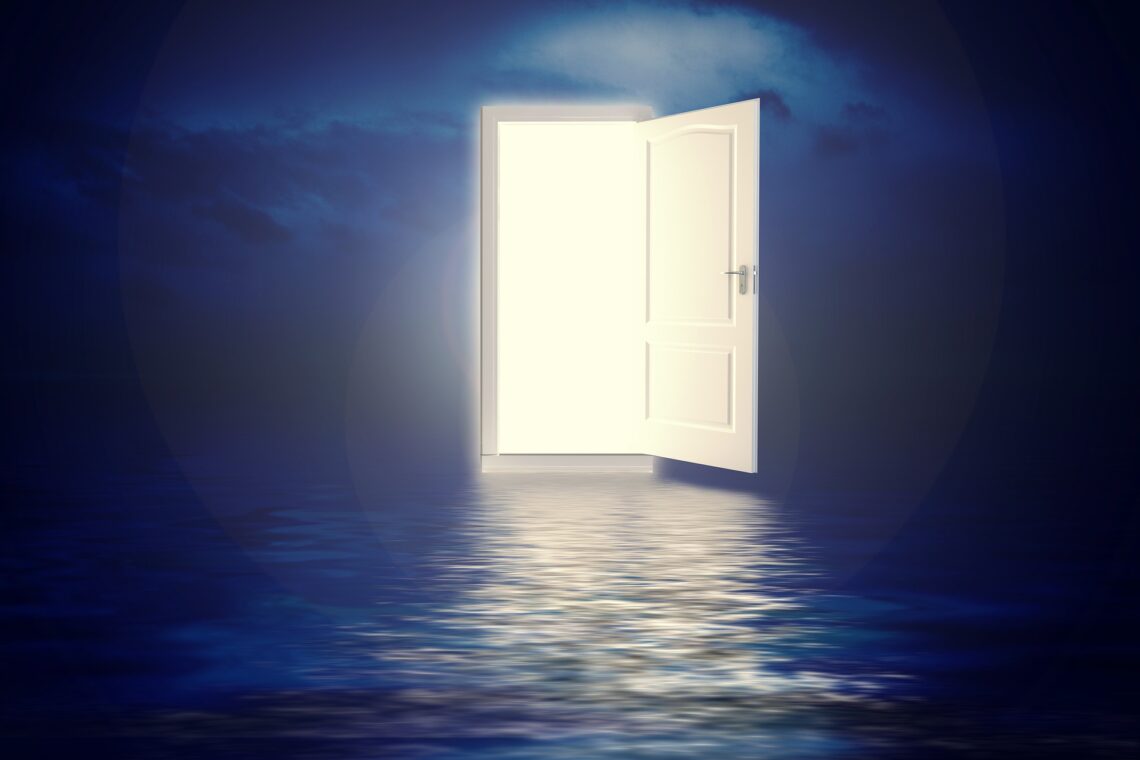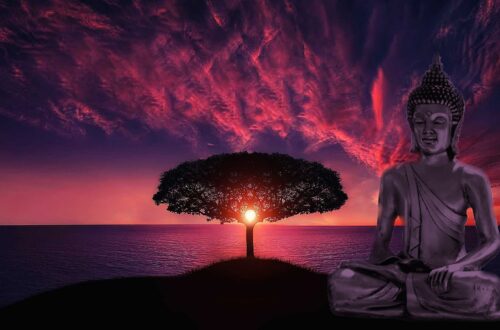
The Bardo of Becoming
We have now just about come full circle. We started out with the bardo of this life, and now we are at the final bardo of the six bardo series, the bardo of becoming, where we end up in the womb of our future parents, whoever or whatever they may be. More on that later.
In the previous bardo, the bardo of dhamata (the after-death state), we had two stages. The Dharmakaya Luminosity where all appearances disappear into the ultimate nature of mind, and the Sambhogakaya Luminosity where those appearances began to arise again out of mind.
The Nirmanakaya Luminosity
In the bardo of becoming we move onto the the third luminosity, the Nirmanakaya Luminosity.
Rinpoche defines the Nirmanakaya and its relation to the Dharmakaya and the Sambhogakaya luminosities.
“In the bardo of dharmata we experienced both the empty essence and the luminous nature of the Dharmakaya and the Sambhogakaya luminosities. These two aspects of essence and nature are the ultimate aspects of this mind. Now, in the bardo of becoming, we experience the mind’s expressive power or aspect of unceasing manifestation which is the Nirmanakaya Luminosity.”
The Nirmanakaya represents mind’s relative reality. In other words, reality as it appears to us, and not the absolute reality of the emptiness of all phenomena
All appearances, whether pure or impure, are expressions of mind’s creative power, and they are unceasing.
These are the appearances of our five senses, along with our thoughts and emotions. We should see them all like images on a TV screen flowing past us non-stop. We shouldn’t get caught up in them. They are just the creative expressions of mind.
If we do get caught up in these appearances, they can cause us great fear and suffering. How we handle them will depend on the habitual tendencies, or karma, our mind that has developed over previous lives. Had we been smart, we would have dealt with these tendencies in the other bardos, leading up to this one.
If we can understand how our mind is the basis for all of these appearances, positive and negative, then we will be better able to deal with them.
Miraculous Power of Karmic Mind
Rinpoche says this about the “miraculous powers of our karmic mind,
“Throughout our lives, we have wondered about miracles—and here they are. We witness the astonishing power of our mind in the miraculous displays of our karma and manifestations of habitual tendencies. If our mind is habituated to negative thoughts, then our mind becomes filled with negative energy that manifests in unpleasant or seemingly hostile appearances. If our mind is habituated to positive thoughts, then, accordingly, we experience appearances that seem to us pleasant and welcoming.”
The Two Stages of the Bardo of Becoming
This bardo is said to last for seven weeks or 49 days, but that can very. It is estimated that the first stage of this bardo lasts for about three weeks, and the second stage for about four weeks. The actual length varies based on the karmic make-up of each individual.
In the first stage of this bardo we still have vivid perceptions of ourselves as the same person we were in the life we just left. We see and hear our family members, friends and others as if we were still alive, engaging with them. Unfortunately, they can’t see and engage with us because they are unaware of our presence. However, we can still see and hear them so what they say about us can have profound psychological and emotional effects on us.
As such, it is important for us, still alive right now, to be aware that family members, friends and others who have recently passed away, may be hanging around us for a time, so we should only think and say supportive things about them and wish them well.
The second stage of this bardo begins when we stop focusing on our past life and begin to focus on our upcoming life. This change is signaled when we see the lights from the “six realms”. We will be reborn into one of these realms.
Rinpoche talks about our state of mind approaching these six realms,
“Since we have not yet been liberated, and we have wandered in an ever-changing and groundless state for what seems like a long time, we may feel drawn to any opportunity to find another body and home. The ‘winds of karma,’ the momentum of our habitual tendencies, will push us toward a realm of rebirth that reflects our most dominant psychological tendencies.”
Because this is such a critical phase in our journey, he counsels us,
“At this point, it is most important to be aware of our mental state and to apply the practices that will be most effective at this time. The lights that appear to us now are not purely ‘wisdom lights,’ like those that manifested in the bardo of dharmata. At this time, dualistic habits of mind have returned and so these lights, which emanate from our mind, are the lights of samsara.”
The lights of samsara will appear paler than the lights of wisdom. We will find ourselves more drawn to some of these paler lights than to others, but the instructions handed down by masters say, don’t be drawn to any of them.
Becoming: Qualities of the Six Realms
It is important to realize these six realms represent psychological states and not physical locations. The six realms are divided into three higher and three lower realms. The higher realms are the god realm, the jealous god realm, and the human realm. Birth in one of these realms is said to be the result of an accumulation of positive karma.
The lower realms are the animal realm, the hungry ghost realm, and the hell realm. Birth here is said to result from less positive or negative karma.
Therefore, there is less suffering and more freedom in the higher realms. In the lower realms there is progressively more suffering and deeper states of ignorance. However, as Rinpoche points out,
“All six realms, however, are within cyclic existence and therefore all include some elements of delusion and suffering.”
Rinpoche explains,
“We are the creator of these states as well as the experiencer of these states. From the Buddhist perspective they are the creation of our individual and group karma. They are projections of our mind manifesting in the experience of a specific realm. It is important to realize that the realm we inhabit right now is a projection of our mind as well.”
Right now, we are inhabiting the human realm, but within it we go through the experiences of all six realms, including the physical, emotional and mental aspects of those realms.
Rinpoche quotes Shantideva, the great Indian mahasiddha (great enlightened teacher),
“There is nothing dangerous in the three worlds [luminosities], other than mind.”
Rinpoche, himself adds on,
“That is, there is nothing more powerful than the mind in terms of its capacity to bring about both negative and positive states.”
A Brief Description of the Six Realms
I am just going to give the briefest of descriptions of the six realms here. For more details, please read this section in Mind Beyond Death.
God Realm
If we follow the white light, we take our rebirth in this realm. While the stay in this realm is more pleasurable with less suffering, our experience here is still subject to samsaric existence. The attraction here is the emotion of pride. We think we have attained the pinnacle of existence, and thus have nothing more to learn or achieve. As a result, our mind is infused with pride. Eventually we realize the god realm is not permanent and we have not reached the peak of existence; therefore, we must continue to endure more suffering through our cyclic existence.
Jealous God Realm
If we follow the pale red light, we take our rebirth in this realm. Jealous gods are also known as demi-gods. This is still a higher realm, but there is less pleasure and more suffering than in the God realm. The dominant emotion here is jealousy, tied to envy, paranoia, and competitiveness.
The Human Realm
If we follow the pale blue light, we take our rebirth in this realm. The dominant emotion here is desire or passion. This is characterized by a poverty mentality. No matter how much we have, we are constantly dissatisfied, discontent, and restless. We always desire more, never thinking we have enough.
Animal Realm
This is the first of the three lower realms. If we follow the pale green light, we take our rebirth in this realm. The dominant emotion here is ignorance, which is not really an emotion, but more an afflicted state of mind. It is one of the three root poisons (kleshas) along with passion and aggression. Here we feel constantly threatened so are always in a state of fear, but since this is normal, we don’t see our fear as the result of our ignorance. We have no self-awareness or capacity for self-reflection. Animals can nourish themselves and care for their young, but can’t avoid aggressive actions like fighting and killing, and thus continue to build up negative karma.
Hungry Ghost Realm
If we follow the pale yellow light, we take our rebirth in this realm. The dominant emotion here is greed which is an aspect of desire in general. Here it is expressed as stinginess or miserliness. One clings to material things and psychological states. Beings here have insatiable appetites, but they can’t partake or enjoy anything. Pictures show them with enormous stomachs, but with tiny mouths and needlelike necks, making ingesting anything almost impossible.
Hell Realm
If we follow the dark, fog-like light, we take our rebirth in this realm. The dominant emotion here is anger and it comes out of the ego’s basic fear and insecurity about its own existence. From this, aversion grows and we become aggressive toward real or imaginary threats. This causes ongoing friction in our relationships, causing us to develop a violent mind, engulfing our entire being in hatred and anger. This complete state of hatred is the definition of hell.
Practices to Help Guide Us Through the Realms
It is said, that as we get closer to rebirth, we will experience extreme states of emotion, mostly of passion and jealousy. This coincides with seeing couples, our potential parents, in union. Rinpoche explains,
“When we see such appearances, we are perceiving a male and female who could become our parents, as well as seeing a potential place of rebirth. If our karma propels us in their direction and we blindly follow, then whatever samsaric realm the couple inhabits will be the realm of our rebirth. It could be an auspicious or an inauspicious situation. We could be seeing a loving couple who have a genuine spiritual practice, or we could be witnessing two dogs copulating. We will not necessarily know the difference if we are blinded by our desire.”
He goes on to take a Freudian perspective,
“It is said that if we are to be reborn a male, then we experience strong feelings of passion toward the mother and feelings of jealousy toward the father. The reverse is true if we are to be reborn as a female. In either case, passion and jealousy arise together.”
So we need to get control of our karma and not let it take us to a realm we don’t want to inhabit. Rinpoche offers this advice.
“However, at this time, we can stop the momentum of rebirth through the different methods of practice in which we have trained. We can transform a samsaric experience into an experience of sacred world through the Vajrayana creation and completion stage practices.”
He goes on to mention other Buddhist practices, that he has covered in some detail throughout his book. However, he sums up what we can do by saying this.
“At the very least, we can slow the process and inject into it a degree of mindfulness and awareness that will allow us to examine the qualities of the parents and the location, and determine the potential to practice dharma that a particular birth will afford. If we train again and again according to these instructions, then at this critical moment in the bardo of becoming, we will naturally manifest in a way that liberates us from samsara.”
So, it is critical in this last part of the bardo of becoming, as it is throughout all the bardos, to practice mindfulness and being in the moment. In this way, we can stop, take a look around, and examine our situation in order to make the best choice for our next life. It even seems possible at this last moment to escape the wheel of samsara.
If there is one clear message from all six bardos, it is to be mindful and live in the moment.
The rest of the chapter goes into more detail about how to prepare for this critical moment of rebirth and is well worth investigating. This completes the cycle of the six bardos. If you missed any of the others, here are the links. Happy Journeying!
An intro to Mind Beyond Death: Link
Intro to the Bardos: Link
The First Bardo: The Bardo of This Life: Link
The Second Bardo: The Bardo of Dream: Link
The Third Bardo: The Bardo of Meditation: Link
The Fourth Bardo: The Bardo of Dying: Link
The Fifth Bardo: The Bardo of Dharmata (the After-Death State): Link
To learn more about the magic of the universe: Click this link: The Magical Universe.
Image by Gerd Altmann from Pixabay




